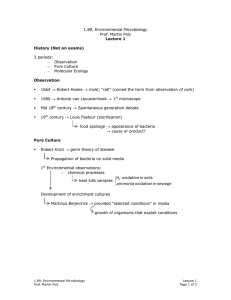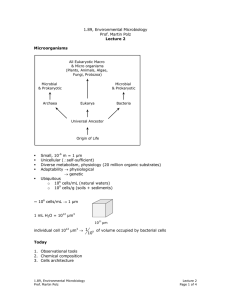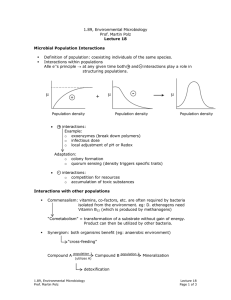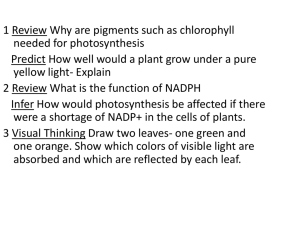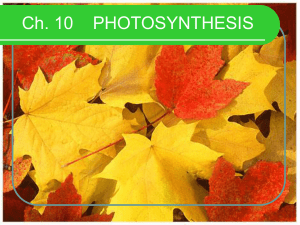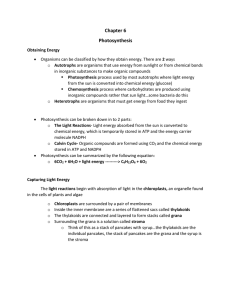1.89, Environmental Microbiology Prof. Martin Polz Energetics: biomass yield optimized
advertisement
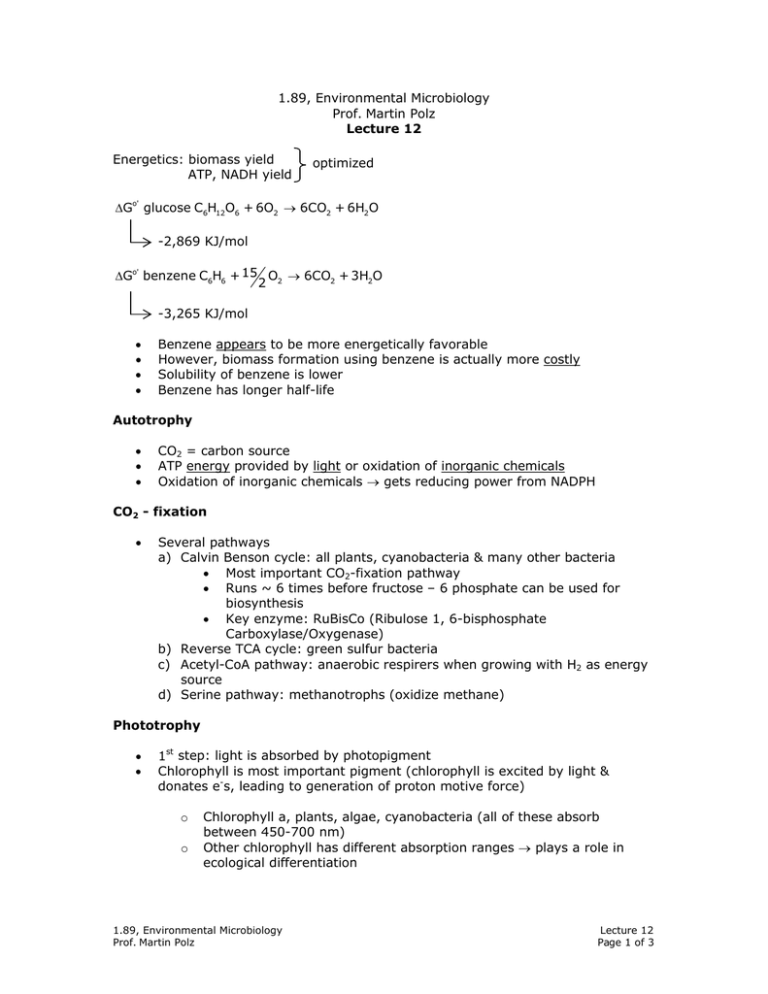
1.89, Environmental Microbiology Prof. Martin Polz Lecture 12 Energetics: biomass yield ATP, NADH yield optimized ∆Go' glucose C6H12O6 + 6O2 → 6CO2 + 6H2O -2,869 KJ/mol ∆Go' benzene C6H6 + 15 O2 → 6CO2 + 3H2O 2 -3,265 KJ/mol • • • • Benzene appears to be more energetically favorable However, biomass formation using benzene is actually more costly Solubility of benzene is lower Benzene has longer half-life Autotrophy • • • CO2 = carbon source ATP energy provided by light or oxidation of inorganic chemicals Oxidation of inorganic chemicals → gets reducing power from NADPH CO2 - fixation • Several pathways a) Calvin Benson cycle: all plants, cyanobacteria & many other bacteria • Most important CO2-fixation pathway • Runs ~ 6 times before fructose – 6 phosphate can be used for biosynthesis • Key enzyme: RuBisCo (Ribulose 1, 6-bisphosphate Carboxylase/Oxygenase) b) Reverse TCA cycle: green sulfur bacteria c) Acetyl-CoA pathway: anaerobic respirers when growing with H2 as energy source d) Serine pathway: methanotrophs (oxidize methane) Phototrophy • • 1st step: light is absorbed by photopigment Chlorophyll is most important pigment (chlorophyll is excited by light & donates e-s, leading to generation of proton motive force) o Chlorophyll a, plants, algae, cyanobacteria (all of these absorb between 450-700 nm) o Other chlorophyll has different absorption ranges → plays a role in ecological differentiation 1.89, Environmental Microbiology Prof. Martin Polz Lecture 12 Page 1 of 3 Accessory pigments • • Example: carotenoids Also capture light → energy transfer to chlorophylls 2 types of photosynthesis 1. Anoxygenic Photosynthesis → oxygen is not created as an end product • Anaerobic bacteria • Cyclic e- flow Reducing power • Excited chlorophyll comes from H2S, etc. • Donates e- into e- transport chain • Leads to generation of H+ gradient • e- ultimately reduces an oxidized chlorophyll molecule • NADPH generation occurs via “Reverse-flow” • Inorganic compounds (H2S, So , Fe2+, H2) serve as electron donors Quinines = e- donors & are oxidized (but many are too electropositive to directly reduce for NADP+ (regenerate NADP+ ⇒ they are ∴ oxidized by components of e- transport chain) NADPH) Reducing power comes from H2O 2. Oxygenic → oxygen is created as end product (Figure 15.19) • 2 photosystems (PS): PSI (analogous to anoxygenic PS) & PSII (replenishes e- lost by PSI and uses H2O as e- donor (O2 generated as result)) • ATP generation occurs via cyclical e- flow in PSI • NADPH generation occurs via “z-scheme” where PSII acts as an edonor for PSI (which is oxidized by NADP+ reduction) • e- in PSII replenished by H2O → 1 O2 + 2H+ 2 Lithotrophy • Diverse group of bacteria which gain energy by oxidation of inorganic chemicals with molecular O2 (or NO-3 ) • Hydrogen oxidizers: H2 + 1 O2 → H2O 2 Nitrifiers: 2 types: 1. Ammonia oxidizers → nitrite 2. Nitrite oxidizers → nitrate • Biosynthesis: both processes are not very efficient, must use a lot of N substrate to get 1 mol C5H7O2N 1. 55NH+4 + 76O2 + 109HCO-3 → C5H7O2N + 54NO-2 + 57H2O + 104H2CO3 2. 400NO-2 + NH+4 + 4H2CO3 + HCO-3 + 195O2 → C5H7O2N + 3H2O + 400NO-3 biomass Energy: 1. NH+4 + 3 2 O2 → NO-2 + 2H+ + H2O 2. NO-2 + 1 2 O2 → NO-3 1.89, Environmental Microbiology Prof. Martin Polz Lecture 12 Page 2 of 3 Note: denitrifiers use NO-3 as electron acceptors & reduce it to N2 gas. e- acceptor • + 4 Anamox: 5NH + 3NO-3 → 4N2 + 9H2O + 2H+ wastewater treatment? – need exact stoichiomethry (no O2, add NO-3 ) Chemolithoautotrophs: All need reduced chemicals & oxygen or nitrate as eacceptors. 1.89, Environmental Microbiology Prof. Martin Polz Lecture 12 Page 3 of 3

